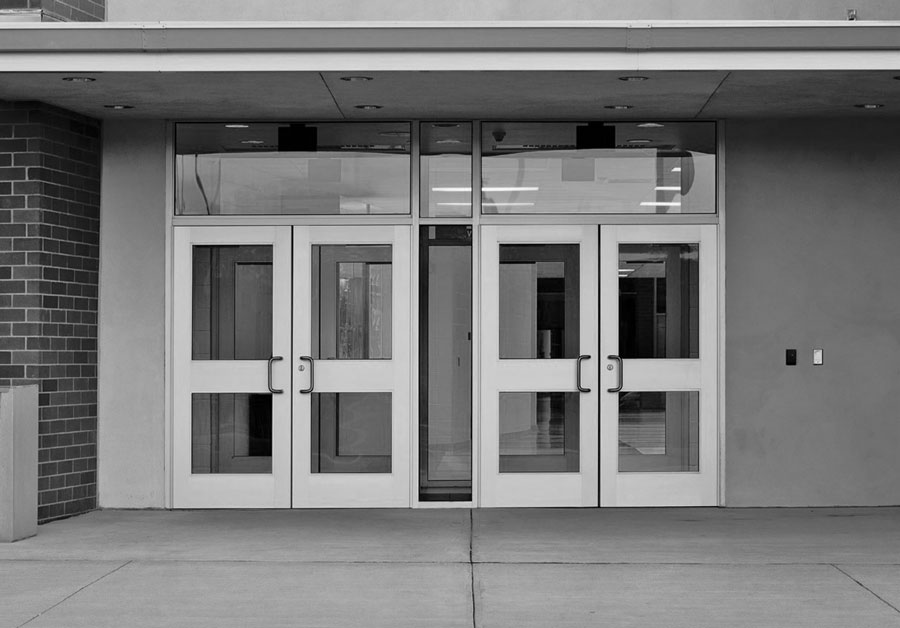School Security: Making smart door choices
Door hardware, particularly locks, must be carefully chosen to ensure safety and security — not just during lock down situations, but every day.
The growing frequency of active shooter events in America has put school safety measures in the spotlight. As recently as fifteen years ago, few people paid much attention to school doors and locks. But now, with active shooter events up from an average of five per year in 2000 to 2004 to 23 per year in 2014 to 2018, school safety and security measures have taken on a new level of importance.
Facility managers and building owners are now paying more attention to the issue and realize that school doors need to do a lot more than open and close. Some schools have even installed barricades to protect students from active shooters. But, as I’ll explain in this article, installing barricades is not a good idea. I’ll also demonstrate how choosing the right door design and door hardware can:
- Protect students from unwanted outsiders,
- Let students exit quickly and safely in an emergency, and
- Prevent fire and smoke from spreading throughout the building.
Door hardware mistakes
The increased attention on school security has been a double-edged sword: while many additional security measures are helpful, the knee-jerk reaction to implement every measure possible to protect against active shooters can actually put student safety at risk. The key for facility managers is to balance security and student safety while complying with codes and standards.
Barricades, touted for their ability to keep out active shooters, actually introduce new hazards for students and violate state and/or local laws as well as safety codes and standards, including the American Disabilities Act (ADA), the International Building Code (IBC), and the International Fire Code (IFC). While a barricade can effectively prevent an active shooter from entering a room, they can also:
- Trap occupants inside a room when they really need to get out (during a fire, for example),
- Block or hinder someone (such as a teacher or police officer) who needs to enter a room to provide help, and
- Even facilitate an assault if one or more assailants barricades themselves in a room with students.
Tragically, barricades have been used by active shooters at Virginia Tech, the West Nickel Mines School, and the Platte Canyon High School to barricade themselves in a classroom with students.
While barricades are always installed at schools with good intentions, the negative consequences of their use outweigh the benefits. The video below demonstrates how barricades put students at risk — and why locks are a better choice.
Choosing the right door hardware
A high-quality lock installed in compliance with safety codes such as the NFPA Life Safety Code can simultaneously protect students from unwanted visitors and permit students to safely leave the room if necessary.
It may be hard to believe that something as simple as a lock can effectively protect students from active shooters, but to date no active shooter has violated a lock. In some cases, assailants were able to break the glass in the door and attempted to reach around to release the lock, but were unsuccessful. A simple way to stop assailants from attempting this is to either remove the glass and use a solid door or replace the glass with a stronger, impact-resistant product.
Any door security solution has to follow the National Association of State Fire Marshals guidelines and the Building, Fire, Life Safety and Accessibility Codes (see here for more information). Doors must be:
- Easy to open from the inside,
- Lockable and unlockable from the outside,
- Located between 34” and 48” above the floor,
- Not require tight grasping, twisting, or pinching to operate, and
- Be easily lockable in an emergency.
Door locks need to allow authorities to enter a locked room if necessary. That way, if students or a teacher lock the door from the inside, medical or law enforcement personnel will still be able to get in to help (using a special key or code).
Locks are an affordable solution for school safety and security
Most schools face budgetary constraints and cannot afford complex security measures. Fortunately, high-quality locks and secure doors are affordable and simple to install. There is no need to invest in high-grade barricades to keep students safe. Smart door and lock choices in accordance with safety codes are more than sufficient.
Want to learn more?
Please visit lockdontblock.org for more information about door security and how to choose the right lock solutions for your school. They have several invaluable resources including a three-step guide for assessing whether your school has code-compliant locks.
For more in-depth information, visit the Door Safety & Security Foundation where you’ll find useful guides and links to building codes by state.

